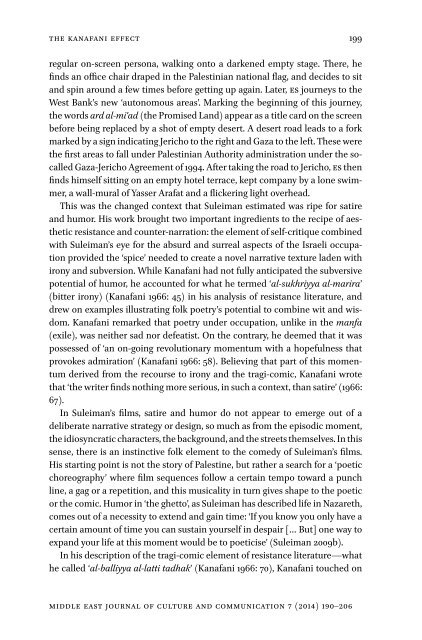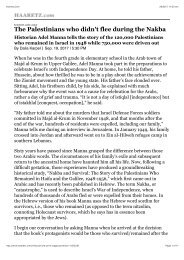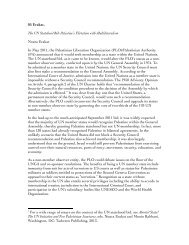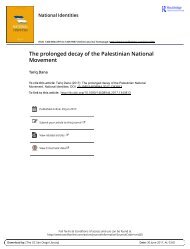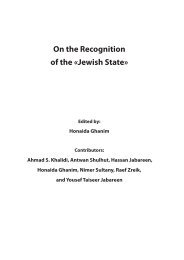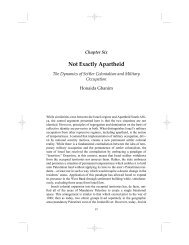The Kanafani Effect: Resistance and Counter-Narration in the Films of Michel Khleifi and Elia Suleiman
Guided by Ghassan Kanafani’s seminal studies on ‘resistance literature’, this paper extends the concept to contemporary Palestinian fiction film to explore its permuta- tions in the visual medium. - By Refqa Abu-Remaileh
Guided by Ghassan Kanafani’s seminal studies on ‘resistance literature’, this paper extends the concept to contemporary Palestinian fiction film to explore its permuta- tions in the visual medium. - By Refqa Abu-Remaileh
You also want an ePaper? Increase the reach of your titles
YUMPU automatically turns print PDFs into web optimized ePapers that Google loves.
<strong>the</strong> kanafani effect 199<br />
regular on-screen persona, walk<strong>in</strong>g onto a darkened empty stage. <strong>The</strong>re, he<br />
f<strong>in</strong>ds an <strong>of</strong>fice chair draped <strong>in</strong> <strong>the</strong> Palest<strong>in</strong>ian national flag, <strong>and</strong> decides to sit<br />
<strong>and</strong> sp<strong>in</strong> around a few times before gett<strong>in</strong>g up aga<strong>in</strong>. Later, es journeys to <strong>the</strong><br />
West Bank’s new ‘autonomous areas’. Mark<strong>in</strong>g <strong>the</strong> beg<strong>in</strong>n<strong>in</strong>g <strong>of</strong> this journey,<br />
<strong>the</strong> words ard al-miʿad (<strong>the</strong> Promised L<strong>and</strong>) appear as a title card on <strong>the</strong> screen<br />
before be<strong>in</strong>g replaced by a shot <strong>of</strong> empty desert. A desert road leads to a fork<br />
marked by a sign <strong>in</strong>dicat<strong>in</strong>g Jericho to <strong>the</strong> right <strong>and</strong> Gaza to <strong>the</strong> left. <strong>The</strong>se were<br />
<strong>the</strong> first areas to fall under Palest<strong>in</strong>ian Authority adm<strong>in</strong>istration under <strong>the</strong> socalled<br />
Gaza-Jericho Agreement <strong>of</strong> 1994. After tak<strong>in</strong>g <strong>the</strong> road to Jericho, es <strong>the</strong>n<br />
f<strong>in</strong>ds himself sitt<strong>in</strong>g on an empty hotel terrace, kept company by a lone swimmer,<br />
a wall-mural <strong>of</strong> Yasser Arafat <strong>and</strong> a flicker<strong>in</strong>g light overhead.<br />
This was <strong>the</strong> changed context that <strong>Suleiman</strong> estimated was ripe for satire<br />
<strong>and</strong> humor. His work brought two important <strong>in</strong>gredients to <strong>the</strong> recipe <strong>of</strong> aes<strong>the</strong>tic<br />
resistance <strong>and</strong> counter-narration: <strong>the</strong> element <strong>of</strong> self-critique comb<strong>in</strong>ed<br />
with <strong>Suleiman</strong>’s eye for <strong>the</strong> absurd <strong>and</strong> surreal aspects <strong>of</strong> <strong>the</strong> Israeli occupation<br />
provided <strong>the</strong> ‘spice’ needed to create a novel narrative texture laden with<br />
irony <strong>and</strong> subversion. While <strong>Kanafani</strong> had not fully anticipated <strong>the</strong> subversive<br />
potential <strong>of</strong> humor, he accounted for what he termed ‘al-sukhriyya al-marira’<br />
(bitter irony) (<strong>Kanafani</strong> 1966: 45) <strong>in</strong> his analysis <strong>of</strong> resistance literature, <strong>and</strong><br />
drew on examples illustrat<strong>in</strong>g folk poetry’s potential to comb<strong>in</strong>e wit <strong>and</strong> wisdom.<br />
<strong>Kanafani</strong> remarked that poetry under occupation, unlike <strong>in</strong> <strong>the</strong> manfa<br />
(exile), was nei<strong>the</strong>r sad nor defeatist. On <strong>the</strong> contrary, he deemed that it was<br />
possessed <strong>of</strong> ‘an on-go<strong>in</strong>g revolutionary momentum with a hopefulness that<br />
provokes admiration’ (<strong>Kanafani</strong> 1966: 58). Believ<strong>in</strong>g that part <strong>of</strong> this momentum<br />
derived from <strong>the</strong> recourse to irony <strong>and</strong> <strong>the</strong> tragi-comic, <strong>Kanafani</strong> wrote<br />
that ‘<strong>the</strong> writer f<strong>in</strong>ds noth<strong>in</strong>g more serious, <strong>in</strong> such a context, than satire’ (1966:<br />
67).<br />
In <strong>Suleiman</strong>’s films, satire <strong>and</strong> humor do not appear to emerge out <strong>of</strong> a<br />
deliberate narrative strategy or design, so much as from <strong>the</strong> episodic moment,<br />
<strong>the</strong> idiosyncratic characters, <strong>the</strong> background, <strong>and</strong> <strong>the</strong> streets <strong>the</strong>mselves. In this<br />
sense, <strong>the</strong>re is an <strong>in</strong>st<strong>in</strong>ctive folk element to <strong>the</strong> comedy <strong>of</strong> <strong>Suleiman</strong>’s films.<br />
His start<strong>in</strong>g po<strong>in</strong>t is not <strong>the</strong> story <strong>of</strong> Palest<strong>in</strong>e, but ra<strong>the</strong>r a search for a ‘poetic<br />
choreography’ where film sequences follow a certa<strong>in</strong> tempo toward a punch<br />
l<strong>in</strong>e, a gag or a repetition, <strong>and</strong> this musicality <strong>in</strong> turn gives shape to <strong>the</strong> poetic<br />
or <strong>the</strong> comic. Humor <strong>in</strong> ‘<strong>the</strong> ghetto’, as <strong>Suleiman</strong> has described life <strong>in</strong> Nazareth,<br />
comes out <strong>of</strong> a necessity to extend <strong>and</strong> ga<strong>in</strong> time: ‘If you know you only have a<br />
certa<strong>in</strong> amount <strong>of</strong> time you can susta<strong>in</strong> yourself <strong>in</strong> despair [… But] one way to<br />
exp<strong>and</strong> your life at this moment would be to poeticise’ (<strong>Suleiman</strong> 2009b).<br />
In his description <strong>of</strong> <strong>the</strong> tragi-comic element <strong>of</strong> resistance literature—what<br />
he called ‘al-balliyya al-latti tadhak’ (<strong>Kanafani</strong> 1966: 70), <strong>Kanafani</strong> touched on<br />
Middle East Journal <strong>of</strong> Culture <strong>and</strong> Communication 7 (2014) 190–206


